Day 2 of a three-day long weekend of tours today. We spent the day in North Norfolk, trying to catch up with a few of our speciality wintering birds and several long-staying rarities. It was cold and rather windy today, with an east wind off the continent, but it stayed dry all day (earlier in the week, it was forecast to rain all day today!).
We started down at Blakeney. It was rather windy and exposed up on the seawall. We scanned the harbour as we walked out. The tide was almost in and a little roost of waders was lined up on one of the spits. There was a large group of Oystercatchers which were mostly asleep. In front of them, the Dunlin were still busy feeding on the small area of remaining mud. We got them in the scope and found a single Knot in with them. A Grey Plover emerged from the muddy channel nearby. A smart drake Goldeneye was out on the water in front of Halfway House, but diving constantly.
As we came round the corner and up to the gate, a couple of Skylarks flew up from the grass and landed again immediately on the edge of the mud, just a little further along from where we were and close to the path. The Lapland Buntings here often associate with the Skylarks, so we made straight for them. We were in luck – a Lapland Bunting was creeping through the grass beside them. We got it in the scope and had a good look at it, before it disappeared further back into the vegetation.
We walked on a little further and could see a Lapland Bunting in the grass. But as we looked at it, we could see that this was a different bird, more strongly marked with black on the underparts.It gradually worked its way towards us and came out onto the mud. It was still sticking to the few tufts of vegetation or running quickly between them – it did not like to be out in the open. We watched it creeping up and through the dried weed stems, looking for seeds. Stunning views of what can be such a secretive species!
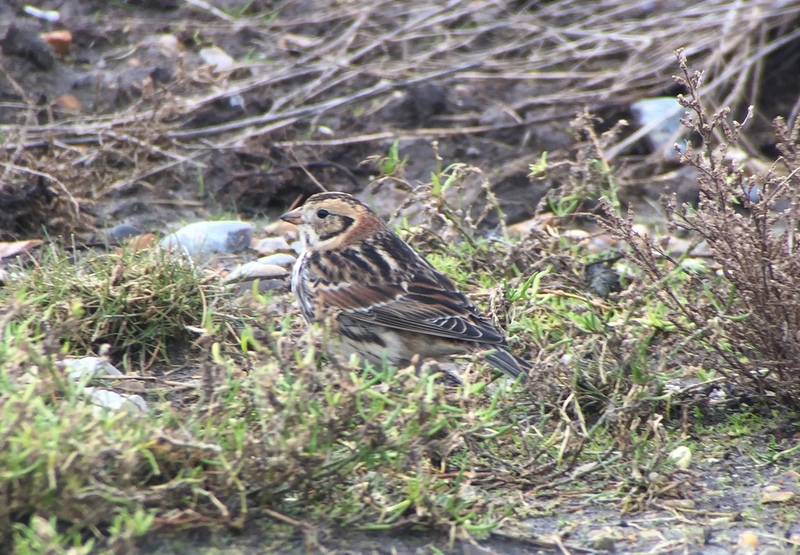

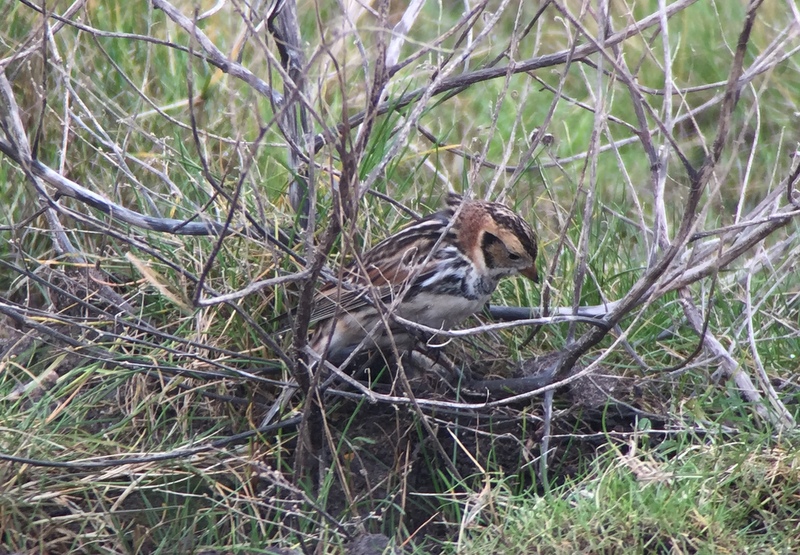 Lapland Bunting – creeping about in the vegetation
Lapland Bunting – creeping about in the vegetation
While we were watching the Lapland Buntings, a little group of seven Twite were out among the tufts of vegetation a little further over. We got them in the scope and had a quick look at them, before they flew off. Three Rock Pipits were feeding round the edge of one of the small pools.
A second Lapland Bunting flew over calling, a dry rattle and a sharp ‘teu’, and the one we had been watching flew up to join it. The two of them raced over towards the gate and dropped down into the grass. We decided that would be a good moment to walk back, and when we got to the gate, some people were watching a Lapland Bunting down in the grass with three Skylarks there.
That was a great start to the day. As we walked back, the tide was now very high and various birds forced out of the saltmarsh were feeding around the Suaeda bushes by the path – a pair of Stonechats, Reed Buntings and Rock Pipits.
 Fallow Deer – a large herd live in Holkham Park
Fallow Deer – a large herd live in Holkham Park
Our next destination was Holkham Park. We parked outside the gate and walked in through the trees. The large herd of Fallow Deer which live in the Park were feeding in the trees close to the path. We got quite close to them before they finally started to run back away from us. We made our way down to the lake.
Several people were watching the female Ferruginous Duck when we arrived, but it was standing preening, half hidden in all the vegetation along the far bank. We managed to get an OK look at it. The stunning male Ferruginous x Pochard hybrid was close by, asleep on one of the branches of a fallen tree lying in the water. It woke up briefly, but swam in deeper underneath the tree and promptly went back to sleep.
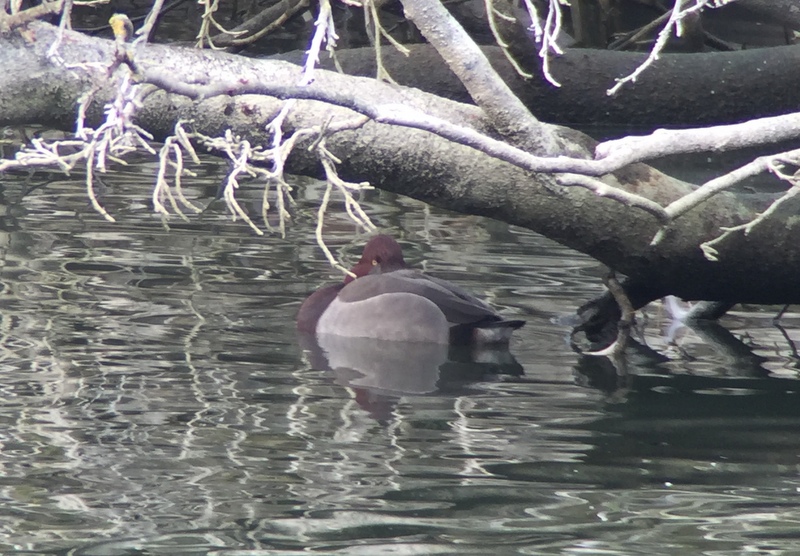 Ferruginous Duck x Pochard hybrid – mostly asleep under the fallen tree
Ferruginous Duck x Pochard hybrid – mostly asleep under the fallen tree
Ferruginous Duck is very common in captivity. Birds routinely escape from wildfowl collections and it is always very difficult to say for certain where odd ducks in an apparently wild state have come from. However, turning up with a hybrid in tow arguably does not aid the credentials of this Ferruginous Duck!
While we were watching the ducks, a shout went up and we turned round to see a Barn Owl flying through the trees not far behind us. Even better it landed on an old tree stump where we could get fantastic close-up views of it. Always a delight to see, it perched for some time, looking round, before flying a short distance and landing again in a tree. It seemed to be performing for the crowd and for a while all the big lenses were trained on it, rather than the ducks.
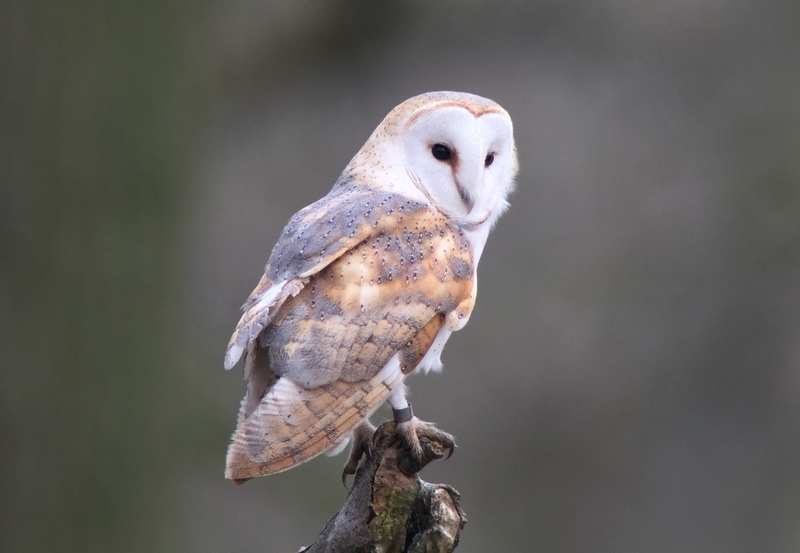 Barn Owl – simply stunning!
Barn Owl – simply stunning!
When the Barn Owl eventually flew off, we made our way down to the north end of the lake, where more Tufted Ducks were out on the water in the more sheltered corner. In with them were the two 1st winter drake Scaup, their grey backs immediately distinguishing them from their commoner cousins. They were preening when we found them, but as soon as they finished they promptly went to sleep. It was obviously bedtime for all the ducks on the lake!
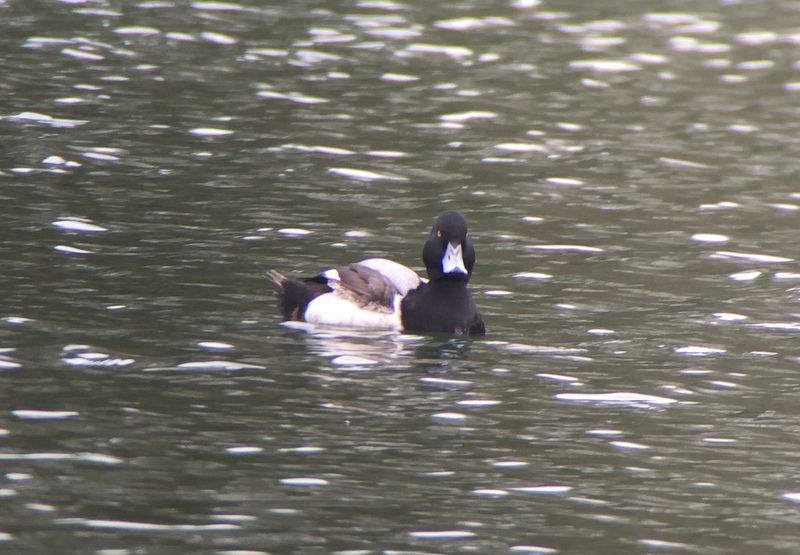 Scaup – one of the 1st winter drakes, preening before bedtime
Scaup – one of the 1st winter drakes, preening before bedtime
We walked back along the side of the lake the way we had come and when we got back to where the Ferruginous Duck was we could see it was now awake and swimming out on the water. This was a much better view.
 Ferruginous Duck – the female of uncertain origin still on the lake
Ferruginous Duck – the female of uncertain origin still on the lake
Then we made our way back through the trees towards the gate. It was mostly rather quiet in here today, but we did hear a Goldcrest and see a Nuthatch in the top of an oak tree. We made a quick stop down on the coast road at Holkham, to scan the grazing marshes. There were a lot of White-fronted Geese out there today, at least 200, the most we have seen here for a while. Then we carried on our way west.
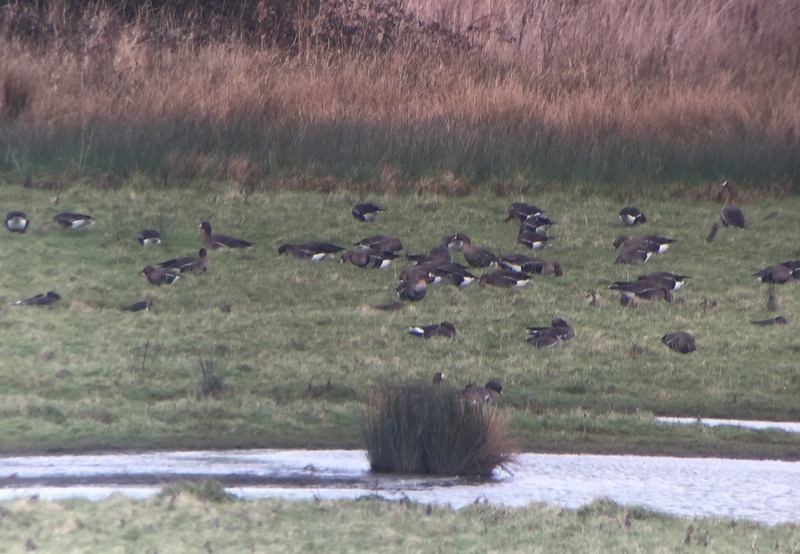 White-fronted Geese – at least 200 on the freshmarsh today
White-fronted Geese – at least 200 on the freshmarsh today
Our next stop was at Brancaster Staithe. The tide was quiet high still and the water very choppy in the wind, but a quick scan located the Red-necked Grebe diving out in the channel. We got it in the scope and watched as it came a little closer, diving all the time.
 Red-necked Grebe – still in the harbour at Brancaster Staithe
Red-necked Grebe – still in the harbour at Brancaster Staithe
That was all nice and easy today, so we quickly turned our attention to the waders. There were several close Bar-tailed Godwits along the shoreline in front of us and a couple of Turnstones running around in the car park. Further over, more Turnstones and several Oystercatchers were picking over the piles of mussels left behind when the catch was brought in and sorted. Eventually, we retreated to the car out of the wind and as we drove out of the car park, we turned to see a group of Black-tailed Godwits feeding in one of the channels.
 Bar-tailed Godwit – in the harbour at Brancaster Staithe
Bar-tailed Godwit – in the harbour at Brancaster Staithe
The day was getting on, but we had a quick swing round via Choseley before lunch. It was very windy and exposed now up on the ridge, and it was no real surprise that we couldn’t find a sign of any of the Rough-legged Buzzards in any of their favourite trees. In contrast, a couple of the local Common Buzzards were hanging in the air, enjoying the breeze.
After a quick late lunch at Titchwell, we walked out onto the reserve. We did not have time to explore the whole reserve today, so it was only going to be a swift visit, but we had a few particular things we wanted to try to see. In front of the visitor centre, there were lots of finches – Chaffinches, Greenfinches and Goldfinches – squabbling over the feeders. A single Lesser Redpoll did well to find a spare port on a feeder and fend off the others for a while. A Coal Tit zipped in, grabbed a seed, and disappeared back into the trees.
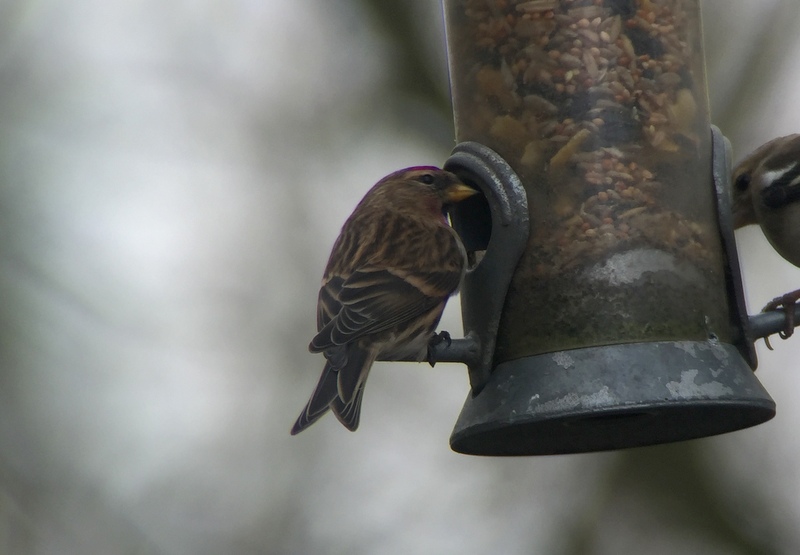 Lesser Redpoll – on the feeders in front of the visitor centre
Lesser Redpoll – on the feeders in front of the visitor centre
Round at the feeders the other side, there was even more variety. A female Brambling was in the bushes behind and kept dropping down onto the feeders briefly, before flying back up. Further up above it, a male Brambling perched in the same bush briefly but promptly flew off. Then a second, even duller female Brambling appeared instead.
 Brambling – a female, coming in to the feeders
Brambling – a female, coming in to the feeders
A smart male Siskin flew in as well and took up position on one of the feeders. It was joined by one of the Bramblings on the other side, until a large Woodpigeon flew in and scared them off.
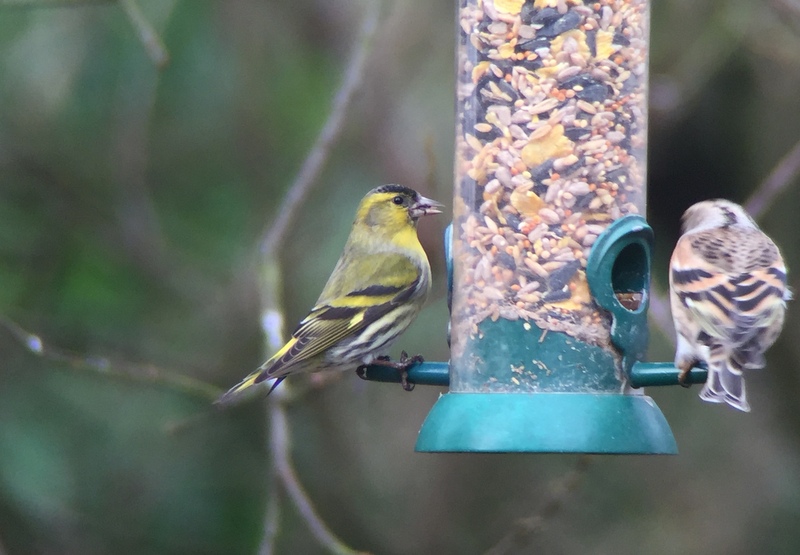 Siskin – with Brambling on the other side
Siskin – with Brambling on the other side
Out on the main path, a quick scan revealed the Water Rail in its usual place in the ditch. It was out in full view today, rooting about in the rotting leaves on the far bank. Giving great views.
 Water Rail – in the ditch by the main path
Water Rail – in the ditch by the main path
It was very windy out on the main path, once we got out of the trees. It was therefore perhaps no surprise to find the dried-up grazing marsh ‘pool’ was devoid of life, save for a single Lapwing. Even though the water level on the freshmarsh has risen a little, there are still not many birds on there at the moment. There were plenty of Teal and a few Gadwall over by the reeds and more Teal over in the deeper water at the back. In amongst them, we could see several Pintail.
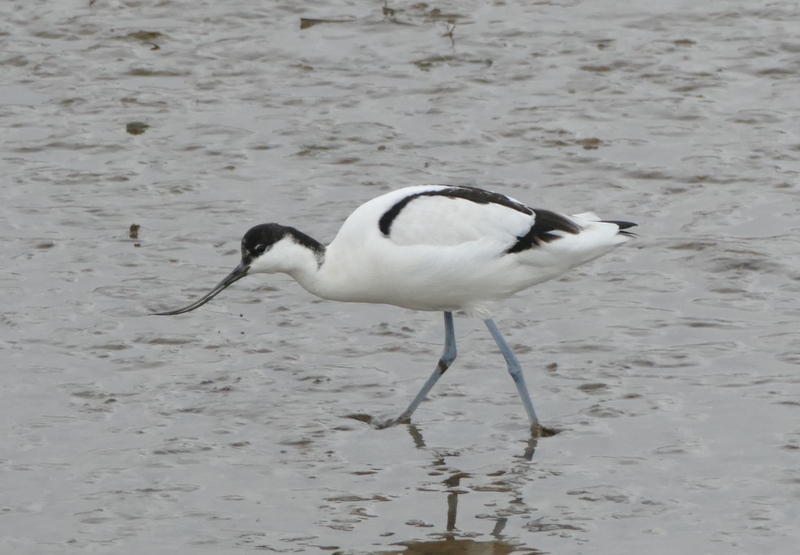 Avocet – around 40 on the reserve at the moment
Avocet – around 40 on the reserve at the moment
Around 40 Avocets were also over the back, a good number for this stage of the winter, along with several small ‘flings’ of Dunlin. There were more waders out on the Volunteer Marsh. A couple of Ringed Plovers were chased off relentlessly by the Grey Plovers. There were also lots of Redshank, plus a few Curlew and Black-tailed Godwits.
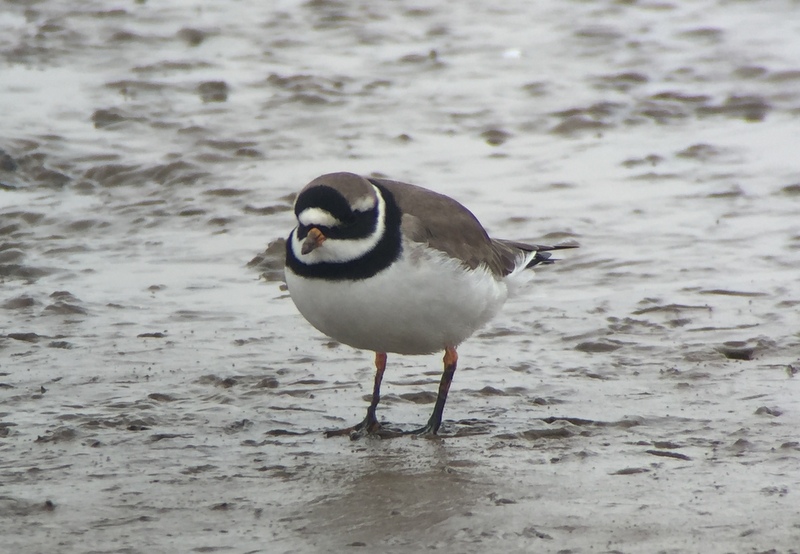 Ringed Plover – chased off by the Grey Plovers
Ringed Plover – chased off by the Grey Plovers
The Tidal Pools have been very productive recently, but were rather quiet today, perhaps because of the blustery wind. The Pintail were all on the freshmarsh and there were few other duck. A single female Goldeneye was diving out in the far corner and only one Little Grebe came out of hiding today.
The tide was out on the beach and there were plenty of waders out around the shellfish beds. We really wanted to catch up with some seaduck today, but it was not really the weather for it, as the wind had whipped up a bit of swell. We found the flock of Common Scoter, but it was just too windy to see for sure if there was anything else in with them and they singularly refused to flap their wings or fly. Most of the Red-breasted Mergansers were over towards Brancaster, but a pair flew over us and down across the beach, landing just offshore, where we could get a better look at them. We decided to beat a retreat.
Back at the grazing meadow ‘pool’, all again seemed deserted at first, there were not even any Rock Pipits out there today. As we got to the gap in the reeds at the front, a shape moved on the edge of the small pool just beyond and a quick look confirmed it was a Water Pipit. We got it in the scope and had a good look at it, before it walked back out of view behind the reeds. It had found the one sheltered spot out of the wind – we were lucky that it happened to come out into the open as we were passing.
Beyond the rushes, out over the grazing meadow itself, the Barn Owl was already out hunting, despite the wind, flying back and forth over the grass. As we got back almost to the junction for the visitor centre, we could see it perched on a fence post. We had a quick look at it through the scope, but we had perhaps been a bit spoiled by the performance earlier as the level of interest was not as high this afternoon!
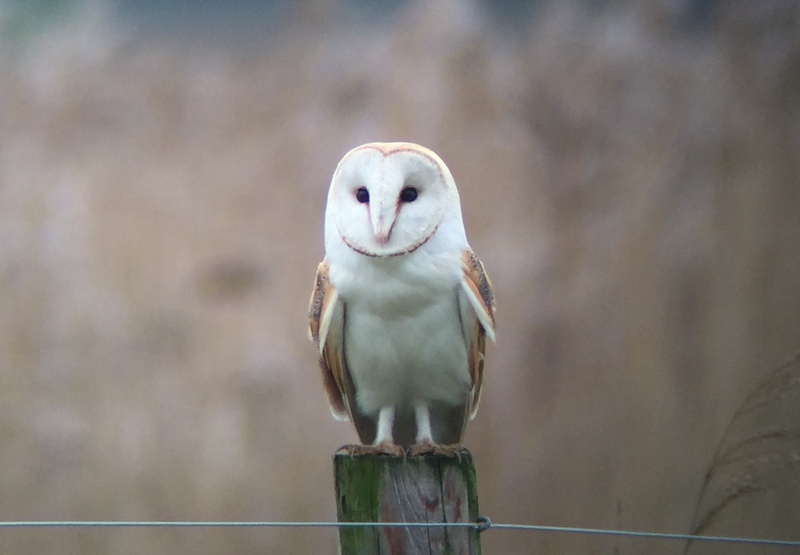 Barn Owl – our second of the day, at Titchwell
Barn Owl – our second of the day, at Titchwell
Time was really pressing now, as we had somewhere else we needed to be, but we had a quick swing round via Choseley just in case, which not surprisingly proved fruitless. Then we cut across country to Roydon Common. It was almost 4pm when we got there and there was nowhere to park – there were an unbelievable number of cars there this evening. We found somewhere we could get off the road and walked back to the car park. Several people were scanning from beside the cars and kindly confirmed the Pallid Harrier was already in and perched on a post. A quick look through a kind person’s scope there, and then we decided to make our way quickly out along the path to where we could get a closer look.
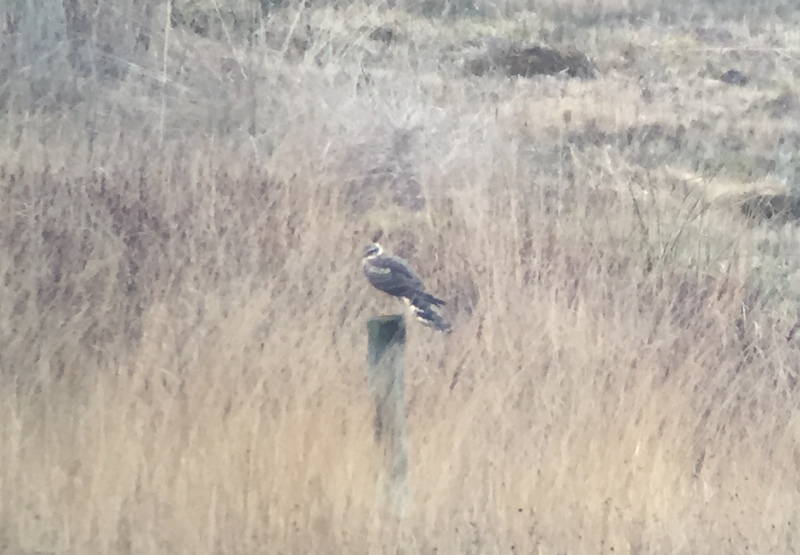 Pallid Harrier – perched on a post when we arrived
Pallid Harrier – perched on a post when we arrived
It was the right decision. We got a much better look at the Pallid Harrier from here, just in time before it took off and flew round, before turning and heading straight for us. It turned away and came round behind us, working along the fenceline on the ridge, dropping down to the ground before climbing back up with something in its talons. Whatever it was, it was not to its liking as it was promptly dropped again. It worked its way over towards the entrance track, hanging in the air for a while, before swinging away and dropping down out of view.
We waited a while and then noticed that the Pallid Harrier was back up again, flying around the trees. Finally it turned and came straight towards us, flying along the ridge just behind us. Great stuff! It dropped back down across the heather and landed again on the same perch it had been on earlier.
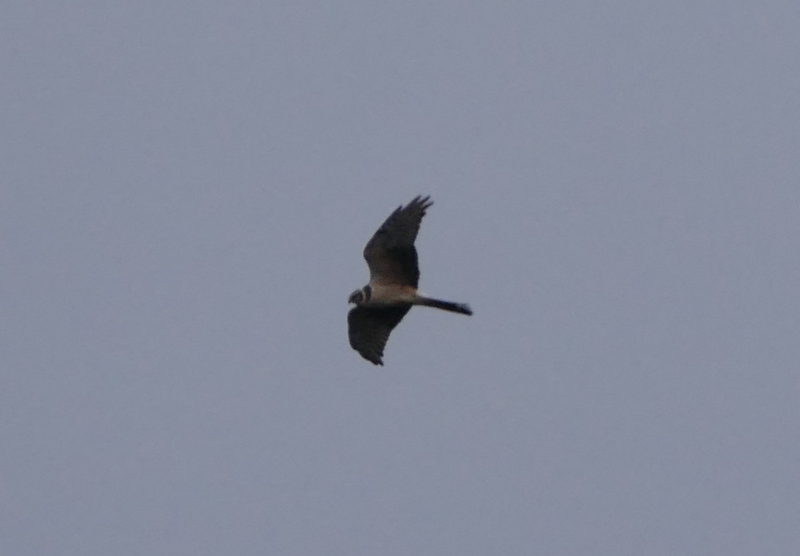 Pallid Harrier – fantastic flight views this evening
Pallid Harrier – fantastic flight views this evening
Over the next half an hour, we watched it flying round. The Hen Harriers were starting to gather now too, and we had 3-4 ringtails also circling out over the grass. It was fantastic to see the two species side by side, noting the small size and slim falcon-like wings of the Pallid Harrier. At one point we had a Hen Harrier on one post and the Pallid Harrier on another, only a short distance away. Then the Pallid Harrier did another circuit of the heath, coming towards us again, giving us a great flypast low over the grass just at the bottom of the heather bank in front of us. Cracking stuff! And with the light starting to fade, that seemed like the perfect point to call it a day. What a day it had been!
















